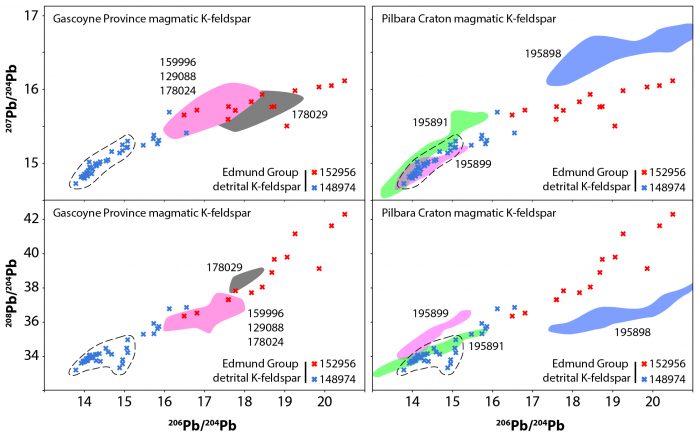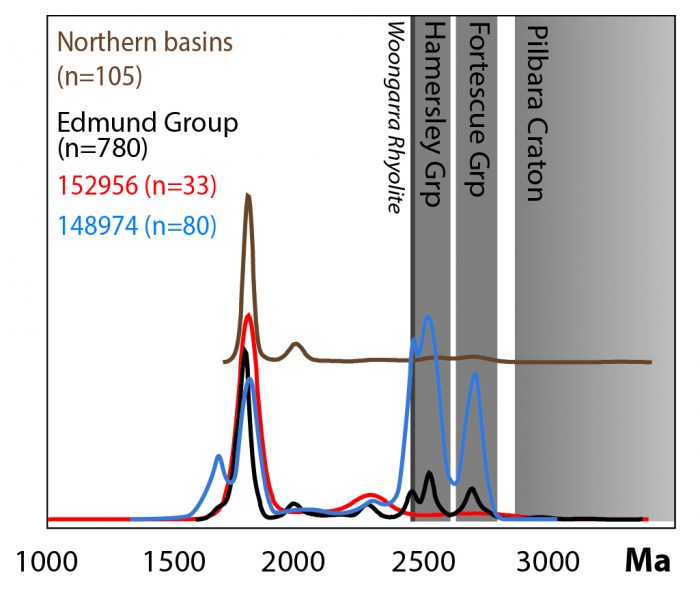
The quest to understand where something has come from pervades many avenues of science. One important field of geological research is tracking the parenthood of sedimentary rocks through sedimentary provenance studies. When rocks are exposed at the Earth’s surface, they are subject to both physical and chemical weathering, where they are broken down into finer-grained components that ultimately form sediment. These sediments are transported away from their source region, most commonly by streams and interconnecting river systems, to sites of deposition that can be hundreds or thousands of kilometers from their original source.
Provenance studies, which examine the petrological or geochemical composition of sedimentary rocks or their mineral components, aim to reconstruct and interpret the pathway of sediment formation and dispersal by characterizing source rock and sediment isotopic signatures. These studies, in both modern and ancient systems, are important as they provide evidence on the timing of a wide range of earth processes such as plate collisions, uplift, and exhumation, or global changes in environmental conditions.
Furthermore, such studies can be critical in understanding hydrocarbon or mineral-rich basin evolution. Since sediment source regions are commonly areas of rapidly uplifting crust, such as the present-day Himalaya, they may also be the sites of significant metal accumulation in the form of ore deposits, as uplift is facilitated by faulting and accompanying fluid flow — two major components needed for metal ore formation. Therefore, correctly identifying sediment pathways, particularly in deeply eroded, ancient sedimentary systems, is critical for reconstructing past tectonic events, but also identifying regions of crust that may be prospective for major ore deposits.
Provenance methods
Over the past two decades, the isotopic dating of uranium-bearing minerals (called zircon) in sediment (e.g. detrital zircon) has become the choice of provenance investigation because zircon grains are ubiquitous in sandstones, highly resistant to both chemical and physical weathering, amenable to dating (i.e. they contain uranium that over time changes to lead at a well-understood rate) and carry other chemical signatures that may uniquely link a zircon grain to its original source. Nearly all original source regions of zircon are igneous rocks. However, the robust nature of zircon provides a challenge to provenance reconstruction as in many cases, a major source of sediment detritus is the uplift, erosion, and recycling of pre-existing (meta-)sedimentary basins (and their detrital components; e.g. Campbell et al., 2005; Anderson et al., 2016).
In essence, once a zircon has been incorporated into a sediment, it will remain within that sediment as it goes through the rock cycle, of uplift, erosion, sedimentation, heating, and melting. So the zircon will be trapped within this rock cycle once, twice, thrice, or more times. The longevity of the sedimentary cycle means that apparent sediment pathways may, in reality, be much more cryptic than that which can be defined solely by the detrital zircon cargo of sedimentary rock.
One novel approach to identify primary, as opposed to recycled, sediment source regions is to use a common rock-forming mineral that is unlikely to survive more than one erosion-transport-deposition cycle. K-feldspar is a common mineral in many sedimentary rocks and is a major constituent of igneous rocks (e.g. granites) that make up the crystalline basement of continental crust. K-feldspar’s propensity to chemical and physical weathering means that it is unlikely to be recycled through one or more sedimentary cycles.
K-feldspar has appreciable concentrations of lead with little to no uranium. That lack of uranium is key so that there is no change of the lead isotopic ratios through time as a function of radioactive decay of uranium. This lack of uranium means that K-feldspar will not yield an age like zircon but a comparison of the measured lead isotope variations in the detrital K-feldspar can be made directly to those of magmatic K-feldspar in igneous rocks, in potential basement source regions (e.g. Tyrrell et al., 2006).
The Capricorn Orogen case study
The Capricorn Orogen is an ancient ~1000 km long, ~500 km wide collision zone between the Archean Yilgarn and Pilbara Cratons of Western Australia (Johnson et al., 2017). The orogen comprises the deformed margins of the two Archean cratons, Proterozoic granitic and metasedimentary rocks of the Gascoyne Province as well as numerous younger sedimentary basins including the Paleo- to Mesoproterozoic Edmund Basin. The Edmund Basin is dominated by sandstone units containing detrital zircons that are similar in age and isotopic composition to the underlying igneous rocks of the Gascoyne Province; however, abundant, well-developed sedimentary rock structures (such as cross stratification), suggest a primary sediment source to the north of the Gascoyne Province (Martin et al., 2008). This observation implies that the zircon detritus in the basin was recycled through older basin systems. Many of these sandstones also contain detrital K-feldspar, and so provide a unique opportunity to test the power of comparing lead isotopes of detrital and magmatic K-feldspar in sedimentary provenance studies.
Detrital K-feldspar from two sandstone units in the Edmund Group and magmatic K-feldspar from six felsic igneous rocks, four from the Gascoyne Province, and two from the Pilbara Craton were selected for in situ, lead isotope analysis by laser-ablation inductively-coupled plasma mass spectrometry at the John DeLaeter Centre at Curtin University.

Fig. 1. Simplified geological map of the Capricorn Orogen of Western Australia, showing the location of samples studied. The geological legend is provided as a stratigraphic column in (b) which shows possible pathways for recycling of detrital zircons. Inset in (a) is a simplified tectonic map of Australia. Abbreviations: GC—Gawler Craton; KC—Kimberley Craton; NAC—North Australian Craton; PC—Pilbara Craton; SAC—South Australian Craton; WAC—West Australian Craton; YC—Yilgarn Craton. Image republished with permission from https://www.sciencedirect.com/science/article/pii/S1674987118300884?via%3Dihub under a CC BY-NC-ND 4.0 license.
Lead isotopes of K-feldspar
Despite the relatively low number of magmatic K-feldspar samples analyzed from the Gascoyne Province basement, there is remarkable consistency of lead isotope composition within, and between samples suggesting that, despite the magma’s complex transport and emplacement mechanisms (Johnson et al., 2017), there was a communal province-wide source of lead to the magmatic system. This is in contrast to the magmatic K-feldspar grains from felsic igneous rocks from the Pilbara Craton which shows a wide range of lead isotope compositions, both within and between samples.

Fig. 2. Lead isotope composition of detrital K-feldspar from sedimentary rocks of the Edmund Group and magmatic K-feldspar from felsic igneous rocks of the Gascoyne Province and Pilbara Craton. Image republished with permission from https://www.sciencedirect.com/science/article/pii/S1674987118300884?via%3Dihub under a CC BY-NC-ND 4.0 license.
Despite the similarity in age between detrital zircons from sandstones within the Edmund Basin and magmatic zircons from igneous rocks of the Gascoyne Province to the immediate south, the lead isotope compositions of detrital and magmatic K-feldspar are dissimilar. This finding indicates that the detrital K-feldspar in the sandstones could not have been derived by erosion of the Gascoyne Province igneous rocks. Instead, the lead isotope composition of the detrital K-feldspar grains are most similar to magmatic K-feldspar grains from igneous rocks of the Pilbara Craton to the north, a result that is consistent with the paleoflow indicators in the rocks themselves (Martin et al., 2008).

Fig. 3. Kernel density estimates for the age of detrital zircons from the studied samples and Edmund Group, and from older basins in the northern Capricorn Orogen including the Ashburton Formation and Capricorn, Bresnahan and Mount Minnie Groups. Image republished with permission from https://www.sciencedirect.com/science/article/pii/S1674987118300884?via%3Dihub under a CC BY-NC-ND 4.0 license.
The similarity in age between detrital zircons extracted from older sedimentary rocks (the “Northern Basins,” including the Ashburton Formation, Capricorn, Bresnahan and Mount Minnie Groups) immediately to the north of the Edmund Basin, allow the detrital zircon and K-feldspar data to be reconciled, indicating that uplift and erosion of these older sedimentary rocks and underlying igneous rocks of the Pilbara Craton, was the predominant source for sediments in the Edmund Basin. Therefore, the majority of detrital zircons in the Edmund Basin sedimentary rocks have passed through at least one former erosion-transport-deposition cycle. Based on their age and composition, the primary source of these zircons is likely to be the igneous rocks of the Gascoyne Province, which appears to have been uplifted and eroded during an older orogenic cycle, shedding sediment northwards into these “Northern Basins.” The subsequent uplift and erosion of these basins during a younger orogenic event, recycled this detritus, southward into the Edmund Basin.
These results are important as they indicate that the northern part of the Capricorn Orogen was undergoing uplift and erosion during the formation of the Edmund Basin, a result that would not have been supported solely by the detrital zircon data. Recent dating of numerous gold deposits along this margin (Fielding et al., 2018) confirm that gold mineralization occurred at the same time as sediment deposition in the Edmund Basin, and highlights the interplay between geological processes like uplift, basin formation, and mineralization.
These findings are described in the article entitled The complexity of sediment recycling as revealed by common Pb isotopes in K-feldspar, recently published in the journal Geoscience Frontiers.
Acknowledgments:
SJ publishes with the permission of the director of the Geological Survey of Western Australia.
References
- Anderson, T., Elburg, M., Cawthorn-Blazeby, A., 2016. U–Pb and Lu–Hf zircon data in young sediments reflect sedimentary recycling in eastern South Africa. Journal of the Geological Society 173, 337–351.
- Campbell, I.H., Reiners, P.W., Allen, C.M., Nicolescu, S., Upadhyay, R., 2005. He–Pb double dating of detrital zircons from the Ganges and Indus Rivers: implication for quantifying sediment recycling and provenance studies. Earth and Planetary Science Letters 237, 402–432.
- Fielding, I.O.H., Johnson, S. P., Zi, J-W., Sheppard, S., Rasmussen, B., 2018. Neighbouring orogenic gold deposits may be the products of unrelated mineralizing events. Ore Geology Reviews 95, 593–603.
- Johnson, S.P., Korhonen, F.J., Kirkland, C.L., Cliff, J.A., Belousova, E.A., Sheppard, S., 2017. An isotopic perspective on growth and differentiation of Proterozoic orogenic crust: from subduction magmatism to cratonization. Lithos 268–271, 76–86.
- Martin, D.M., Sircombe, K.N., Thorne, A.M., Cawood, P.A., Nemchin, A.A., 2008. Provenance history of the Bangemall supergroup and implications for the mesoproterozoic paleogeography of the West Australian craton. Precambrian Research 166, 93–110.
- Tyrrell, S., Daly, J.S., Kokfelt, T.F., Gagnevin, D., 2006. Common-Pb isotopic composition of detrital K-feldspar grains: validation as a provenance tool and its application to Upper Carboniferous paleodrainage, Northern England. Journal of Sedimentary Research 76, 324–345.









